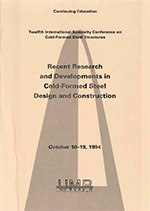Location
Saint Louis, Missouri
Session Dates
18 Oct 1994
Abstract
This paper is concerned with the design of cold-formed steel structural members which span between the frames of a building and carry cladding which is usually either single- or double-skin profiled metal sheeting or a sandwich panel. The cladding is fIxed to these purlins or sheeting rails at regular intervals and the performance in service, and therefore the design, is strongly influenced by interaction with the sheeting. The connection between the purlins and the supporting structure also has a significant influence on performance so that, historically, the emphasis has tended to be on empirical methods of design rather than detailed calculations of the structural behaviour. In a previous paper[1], the fIrst author described the design of a purlin system, known as Multibeam Mark 2, based on a cold-formed steel Sigma profile. The alternative approaches to design were reviewed and a semi-empirical design procedure was described which resulted in safe but competitive load-span tables. This paper describes the design of Multibeam Mark 3. This involves a further evolution of the cross-section together with further improvement of the design procedure. The tendency is to continue to move away from reliance on testing and towards an approach which is much more orientated towards design by calculation, a trend which is becoming increasingly necessary in view of the proliferation of different cladding types, all offering different degrees of restraint to the purlin. It is shown that, in the present state-of-the-art, a design procedure based entirely on calculation, while taking into account such practical factors as restraint from alternative cladding systems and distortion and partial plasticity at internal supports, is now feasible. However, as the profession may not yet be ready for such a radical approach, the design procedure used for Multibeam Mark 3 is backed up by a comprehensive test programme.
Department(s)
Civil, Architectural and Environmental Engineering
Research Center/Lab(s)
Wei-Wen Yu Center for Cold-Formed Steel Structures
Meeting Name
12th International Specialty Conference on Cold-Formed Steel Structures
Publisher
University of Missouri--Rolla
Document Version
Final Version
Rights
© 1994 University of Missouri--Rolla, All rights reserved.
Document Type
Article - Conference proceedings
File Type
text
Language
English
Recommended Citation
Jiang, C. and St. Quinton, D., "Design of a Purlin System" (1994). CCFSS Proceedings of International Specialty Conference on Cold-Formed Steel Structures (1971 - 2018). 4.
https://scholarsmine.mst.edu/isccss/12iccfss/12iccfss-session8/4
Design of a Purlin System
Saint Louis, Missouri
This paper is concerned with the design of cold-formed steel structural members which span between the frames of a building and carry cladding which is usually either single- or double-skin profiled metal sheeting or a sandwich panel. The cladding is fIxed to these purlins or sheeting rails at regular intervals and the performance in service, and therefore the design, is strongly influenced by interaction with the sheeting. The connection between the purlins and the supporting structure also has a significant influence on performance so that, historically, the emphasis has tended to be on empirical methods of design rather than detailed calculations of the structural behaviour. In a previous paper[1], the fIrst author described the design of a purlin system, known as Multibeam Mark 2, based on a cold-formed steel Sigma profile. The alternative approaches to design were reviewed and a semi-empirical design procedure was described which resulted in safe but competitive load-span tables. This paper describes the design of Multibeam Mark 3. This involves a further evolution of the cross-section together with further improvement of the design procedure. The tendency is to continue to move away from reliance on testing and towards an approach which is much more orientated towards design by calculation, a trend which is becoming increasingly necessary in view of the proliferation of different cladding types, all offering different degrees of restraint to the purlin. It is shown that, in the present state-of-the-art, a design procedure based entirely on calculation, while taking into account such practical factors as restraint from alternative cladding systems and distortion and partial plasticity at internal supports, is now feasible. However, as the profession may not yet be ready for such a radical approach, the design procedure used for Multibeam Mark 3 is backed up by a comprehensive test programme.



